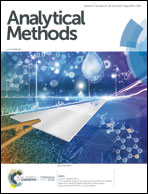Improved quantification of the cyanobacteria metabolite, β-methylamino-l-alanine (BMAA) using HPLC-MS/MS detection of its dansyl chloride derivative referenced to a 15N-labeled internal standard
Abstract
Environmental exposure to the cyanotoxin, β-N-methylamino-L-alanine (BMAA), has been implicated as the etiological agent of a human neurodegenerative disease possessing the combined neuropathologies of amyotrophic lateral sclerosis/parkinsonism-dementia complex (ALS/PDC). However, the hypothesis linking dietary exposure to BMAA in isolated populations to their elevated incidence of ALS/PDC has been criticized due to methodological issues that include a failure to separate BMAA from co-eluting and/or isobaric compounds during quantification. We developed an improved HPLC-MS/MS quantification method for the total fraction of the dansyl chloride (DNS) derivatives of BMAA, 2,4-diaminobutyric acid (DAB), and N-(2-aminoethyl)glycine (AEG). The use of 15N-labelled BMAA as a stable isotope-labeled (SIL) internal standard (15N-BMAA) provides a direct comparison for quantification of total BMAA, and generates a more robust (>20 : 1 peak area) and stable (25.8% vs. 68.2% mean deviation of peak area) MS quantification transition as compared to the deuterated analogue, 2H3-BMAA, used in prior studies. Partial method validation using 15N-BMAA as a SIL internal standard provided high accuracy and precision (R2 > 0.999; S = 0.004) over a wide range of L-BMAA concentrations (0–100 μg g−1 lyophilized material), with improved lower limits of quantification (LLOQ) and detection (LOD) of 22.9 and 2.8 ng g−1 lyophilized material, respectively. BMAA was detected at several sites in the Lower Columbia River (USA) above the LOD, and at concentrations ranging from 23.5 ± 4.5 to 63.3 ± 18.1 ng g−1 lyophilized-material. Use of dansyl chloride derivatization provides a comparable alternative to 6-aminoquinolyl-N-hydroxysccinimidyl carbamate (AQC)-based methods. We note that the use of deuterated SIL standard variants and the derivatization buffer pH used in prior BMAA quantification studies, based on data-dependent acquisition/tandem mass spectrometry methods, may have led to false-negative results, and therefore contributed to the historic disagreement regarding the prevalence and abundance of BMAA.



 Please wait while we load your content...
Please wait while we load your content...